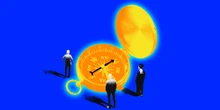New York City’s congestion pricing program has been in place for one month, implementing tolls on drivers who enter certain, often gridlocked, areas of Manhattan. And so far, the results are “undeniably positive,” transit officials say, with measurably reduced traffic and more commuters choosing public transit.
The traffic mitigation plan covers a “congestion relief zone” that spans almost all of Manhattan below 60th street and includes major routes like the Lincoln, Holland, and Hugh L. Carey Tunnels and bridges that go into both Brooklyn and Queens. Since its launch on January 5, one million fewer vehicles have entered that zone than they would have without the toll, according to the Metropolitan Transportation Authority (MTA).
How does congestion pricing work?
Passenger cars with an E-ZPass that travel through that zone face a $9 toll during peak hours, from 5 a.m. to 9 p.m. on weekdays and 9 a.m. to 9 p.m. on weekends, and a $2.25 toll overnight. Tolls are more expensive for commercial traffic, and vehicles without E-ZPass face a 50% premium.
Those charges are meant to reduce traffic in the city and also raise funds for $15 billion worth of transit repairs to the MTA. By cutting traffic and ushering more commuters onto public transit, the program will also reduce air pollution and greenhouse gas emissions.
It’s the first such plan in the United States, though congestion pricing has been successfully used in London, Stockholm, Singapore, and other cities. In Stockholm, traffic levels dropped about 25%, and the city saw less pollution and more investment in local infrastructure. And though business owners and residents there criticized the program before its pilot began—much like they did in New York—a majority of voters ended up making that toll permanent.
Faster trips, more bus riders
New Yorkers are already seeing an impact one month in. Along with fewer drivers in general, the vehicles that still travel through the area are dealing with less traffic. Those crossing through the Holland Tunnel see the most time savings, with average trip times down 48% during peak morning hours. The Williamsburg and Queensboro Bridges are both seeing an average of 30% faster travel times. During afternoon peak hours, drivers in the entire zone are seeing travel times drop up to 59%.
More commuters are opting for buses to cross Manhattan, and those buses are now traveling more quickly, too. Weekday bus ridership has grown 6%, while weekend ridership is up 21%, compared to January 2024. (Subway ridership has also grown by 7.3% on weekdays and 12% on weekends, part of a larger trend in ridership growth happening since the fall, per the MTA. Anecdotally, some subway riders have said they’ve seen more packed trains on their morning commutes.) Buses entering Manhattan from Queens, Staten Island, and the Bronx are saving up to 10 minutes on their route times, which also makes their arrivals more reliable.
This data comes from the MTA, which released figures at the end of January. A full one-month update won’t be available until the next MTA board meeting at the end of February; the MTA didn’t yet release any information on the amount of money the program has raised or any air quality impacts. (When it comes to air quality, some groups have raised alarms about how congestion pricing is moving traffic and its associated air pollution to poorer neighborhoods, like the South Bronx.) But it shows a trend, and the traffic impacts are supported by other data, like from the Congestion Price Tracker run by two Brown University students, Joshua Moshes and Benjamin Moshes.
Driving from Hell’s Kitchen to Midtown East at 5:30 p.m. on a weekday took about 25 minutes on average before congestion pricing, per that tracker. This week, it’s just 15 minutes. Traveling through the Holland Tunnel at 7 a.m. on a Monday once took 23 minutes on average, compared to 14 minutes this week. Some routes, though, like Greenwich Village to Alphabet City within Manhattan are trending “almost identically” to their pre-congestion pricing patterns. There are also “spillover routes” like Park Slope to Dumbo—two Brooklyn neighborhoods entirely outside of the congestion relief zone—that are seeing travel times down by about five minutes or less at various times of the day, though the tracker notes that the program’s effect on these routes isn’t yet fully clear.
One month of data, though, isn’t enough to judge long-term impacts, Moshes told Fast Company. “People’s behavior may change with time. We will keep watching the data to see if things change.” The future of congestion pricing is under threat by President Donald Trump, who is considering halting the program. (A poll by Morning Consult this week found that 59% of voters say Trump should allow it to continue. Another poll, though, revealed that support is still split, with a majority of drivers against it and a majority of pedestrians, bikers, and transit riders in support.)
For right now, at least, congestion pricing is having an immediate impact for commuters. Daniel A. Zarrilli, the chief climate and sustainability officer at Columbia University, shared his firsthand experience on X on January 29: “Tonight: 24 minutes from City Hall to Staten Island by express bus during the evening commute,” he wrote. “That’s gotta be a record.” A caller to WNYC’s The Brian Lehrer Show earlier in January told the host that his wife, who takes an express bus from Bay Ridge, Brooklyn, to Lower Manhattan and back for work, has seen fewer delays every day. “She’s getting home earlier every night,” he said. “I mean, we love it.”










No comments